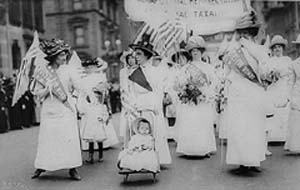
|
Fighting for Women Suffrage |
| When you turn 18 in the United States you can register to vote for the election. But that wasn't always true for women. Before 1920, women weren't allowed to vote. Only men could! This was because most people believed that women were less intelligent when it came to making a political decision. |
 |
In the years of 1840-1920 there were many women suffragists. Suffragist followed by Lucy Burns, Harriot E. Blatch, and Alice Paul. Paul and her followers even chained themselves to the White House fence in protest that women couldn't vote. While protesting, some groups even held marches! However, most suffragists were arrested and taken to jail, where they would go on a protest again by a hunger strike. |
| One great suffrage leader was Virginia Louisa Minor. She was born on March 27, 1824, in Virginia. She married Francis Minor and then settled in St. Louis, Missouri. All her life she was an active leader in groups. When the Civil War began she became a member of the St. Louis Ladies Aid Society. Around 1865, she was the first woman to suggest that women should have the right to vote. Then in 1867 she became president of the Woman Suffrage Association of Missouri. In 1869, she proposed that the 14th Amendment to the Constitution guaranteed equal rights to women. She didn't think it was right that women couldn't vote. In October 1872 she tried to register to vote in St. Louis. When they said she couldn't, she brought a suit against them. The Minor vs. Happersett case was appealed all the way to the Supreme Court. Unfortunately, the appeal was lost. In one way, however it wasn't lost, because it finally attracted attention for women suffrage. Virginia Minor died due to health reasons in St. Louis, Missouri on Aug. 14, 1894, but is remembered by many, as a leading woman for women suffrage. | 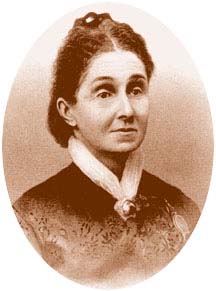
Virginia Louisa Minor |
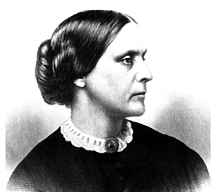
Susan B. Anthony (1820-1906) |
Most people only think of individual suffragists when they think of fighting for women suffrage, but there were two main groups of women that helped women finally get to vote. One group was the National Woman Suffrage Association. This group was founded by Susan B. Anthony and Elizabeth Cady Stanton on May 15, 1869, in New York. Stanton was the groups first President , while Anthony was the groups first Vice-President. They focused on getting women's suffrage state by state and worked to get working women into labor unions. The second group was led by Lucy Stone and her husband Henry Blackwell. This group was called "American Woman Suffrage Association." This second group was more conservative, while the first group was more radical. The American Woman Suffrage Association also wanted to get individual states to allow women to vote. Eventually these two groups united, in 1890, to form the "National American Woman Suffrage Association." This group combined all of their ideas into one. The group still went state by state to win the right for women to vote, but many politicians didn't support votes for women. | 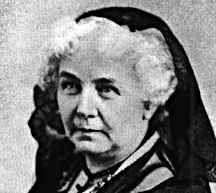
Elizabeth Cady Stanton |
| In 1915, only eleven states had granted full voting rights to women. So in 1916, Carrie Chapman Catt led the National American Woman Suffrage Association in a campaign to get lots of petitions signed. They went to the street asking people to sign, but not all states were convinced. | 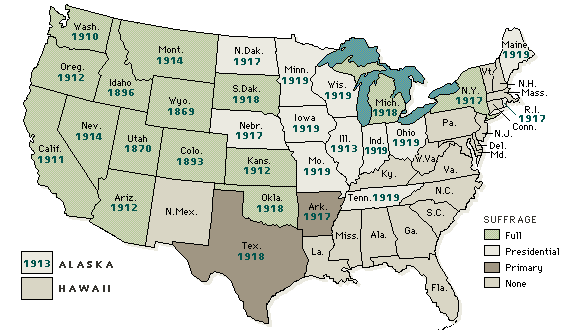 |
| In 1916, some of the people from the
National American Woman Suffrage Association went off to form the National
Woman's Party with Alice Paul. They worked to get Congress to pass a
constitutional amendment giving women the right to vote. Paul led parades
around the White House in this movement. They finally convinced Congress
in 1919 and Congress approved the 19th Amendment, granting equal suffrage
to women. Then it won ratification by least 36 to 48 states, and the House
ratified it by only two votes. One of these votes was made by Harry Burn,
but his district opposed ratification. However, Burn went by what his
mother had told him to do which was "Don't forget to be a good son
and help Mrs.Catt." Congress ended up passing it on June 4, 1919, and
it was ratified August 18, 1920. The 19th Amendment read like this:
"Section 1: The right of citizens of the United States to vote shall not be denied or abridged by the United States or by any state on account of sex." "Section 2: Congress shall have the power to enforce this article by appropriate legislation." |
| The fight for women was a long, difficult journey. Many women were arrested and died in jail, because they went on a hunger strike. The women who helped win this fight were brave and strong. Many people thought that women weren't intelligent, but most people would say that you have to be smart to get Congress to pass an amendment for women suffrage! |
| Bibliography |
| Women's Fight for the Vote: The Nineteenth Amendment, "Exploring Constitutional Conflicts" <http://www.law.umkc.edu/faculty/projects/ftrials/conlaw/nineteentham.htm> 5/17/05 |
| Seeking the Right to Vote, "History of Women's Suffrage: Women's History" <http://www2.worldbook.com/features/whm/html/whm010.html> 5/17/05 |
| Minor, Virginia Louisa <http://search.eb.com/women/articles/Minor_Virginia_Louisa.html> 5/17/05 |
| Herman J. Viola, Helen Wheatly, Diane Hart. Why We Remember. Illinois: Addison-Wesley Educational Publishers Inc. 1998 |
| Pictures |
| Women's Fight for the Vote: The Nineteenth Amendment, "Exploring Constitutional Conflicts" <http://www.law.umkc.edu/faculty/projects/ftrials/conlaw/nineteentham.htm> Suffrage Parade 5/17/05 |
| Virginia Minor and her Fight for Suffrage, "Old Courthouse: Virginia Minor" <http://www.jtharvey.com/arch/och-minor.htm> Virginia Minor 5/17/05 |
| Women Suffrage in the United States <http://encarta.msn.com/media_461531215/Woman_Suffrage_in_the_United_States.html> U.S. Map 5/17/05 |
| March is Women's History Month <http://www.goiam.org/visit.asp?c=5224> Stanton and Anthony 5/17/05 |
| Skylar Flinn
8th American History 2005 Project |